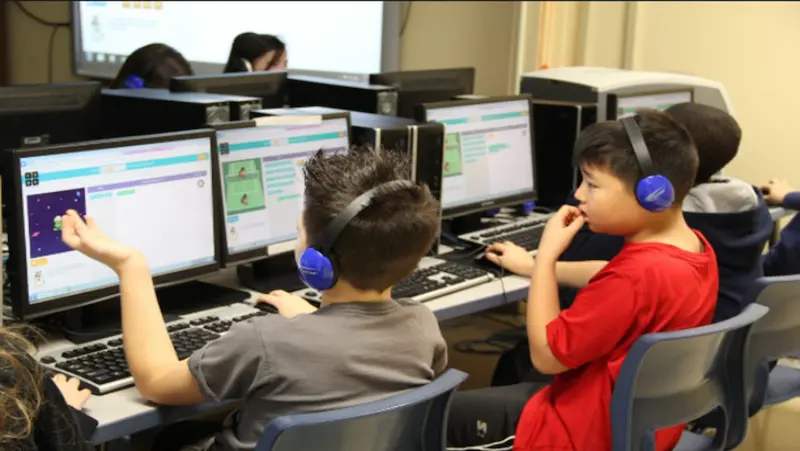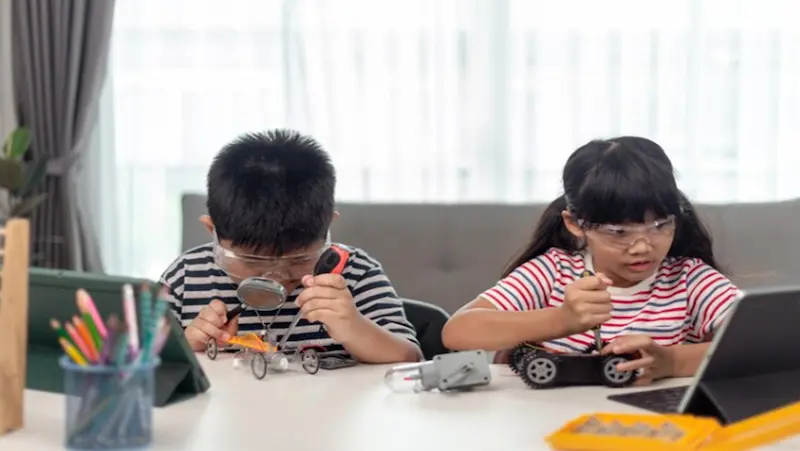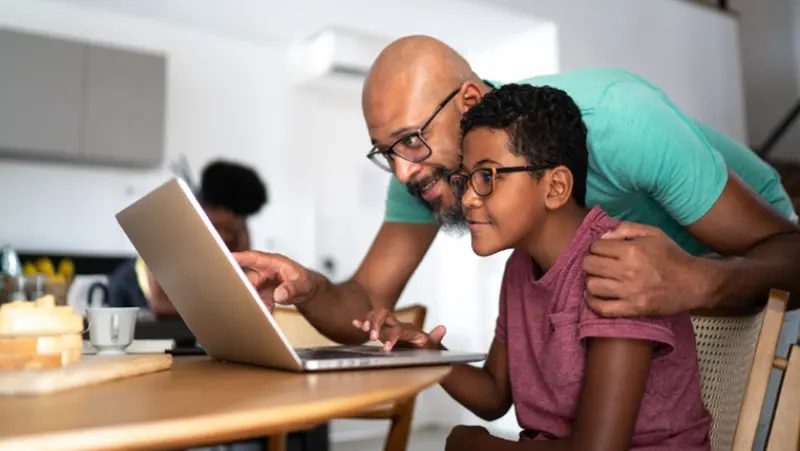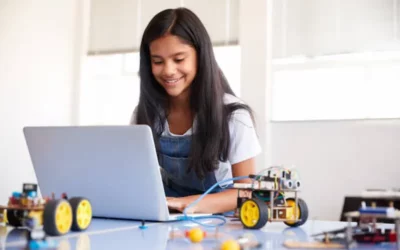In today’s digital age, learning to code has become an essential skill for anyone who wants to stay ahead of the curve. And what better time to start than in childhood?
Introducing coding for kids online is an excellent way to ignite a lifelong passion for technology, programming, and problem-solving. By providing your child with the opportunity to learn coding languages online, you’ll be giving them the tools they need to build their own websites, apps, and video games.
But the benefits of teaching kids coding skills online go far beyond the practical applications. In this post, we’ll explore some of the reasons why coding is such an invaluable skill for kids to learn and why online learning is the ideal medium.
Table of contents
Importance of learning Coding Languages
In today’s technology-driven world, it’s important for children to learn coding skills at a young age. Learning Kids Coding Languages is not only a valuable skill but can also lead to numerous opportunities in the future.
It can improve their problem-solving skills, enhance their logical thinking, and help them understand complex systems better. Moreover, coding for kids online has become more accessible, with several resources available online, including online coding boot camps for kids, and free coding classes for kids online.
Teaching coding to children is an excellent way to prepare them for the future. With the rise of technology, there’s an increasing demand for coders in various industries, such as healthcare, finance, and entertainment.
Moreover, learning to code at a young age can spark children’s interest in pursuing a career in STEM fields. It can also give them a competitive edge in their academic and professional careers.
Aside from the career benefits, Kids Coding Languages also offer several personal benefits. Learning to code can help improve a child’s creativity and encourage them to explore new ideas.
It also enhances their ability to communicate with others and work in a team. Children who learn to code develop essential problem-solving skills, which they can use in other areas of their lives.
Popular Kids Coding Languages
When it comes to coding languages for kids, there are several popular options to choose from. Here are some of the most used languages:
1. Scratch – Scratch is a block-based programming language developed by MIT that allows kids to create games, animations, and interactive stories. It is designed specifically for children and is a great introduction to computer programming for kids concepts.
Scratch is a programming language and an online community where children can program and share interactive media such as stories, games, and animation with people from all over the world. As children create with Scratch, they learn to think creatively, work collaboratively, and reason systematically.
Scratch is designed, developed, and moderated by the Scratch Foundation, a nonprofit organization. Tutors encourage kids, via engaging projects, to create fun, interactive, and animated games as well as code their Ozobot to race, dance, and even complete the FunTech maze!
Age guide: 8 to 16 years old
2. Python – Python is a popular text-based programming language that is used by many professional programmers. It is a great option for kids who have already mastered scratch coding for kids and want to take their coding skills to the next level.
This programming language teaches your child the ins and out of Python for kids through practical exercises and projects – plus plenty of hands-on learning. It is easy to learn and can be used to write all sorts of computer programs.
Python is used to build games, online tools, and websites. Topics such as datatypes, variables, user inputs, branching, iteration, functions and so much more, can be taught to kids to keep them occupied and engaged all day.
Age guide: 10 to 16 years old

3. JavaScript – JavaScript is a popular web-based programming language that is used to create interactive web pages. It is a great option for kids who are interested in web development and want to learn how to create dynamic web content.
JavaScript is the secret sauce that makes the Web awesome, your favorite sites interactive, and online games fun! There are many resources like tutorials, free courses & books to introduce this lighthearted language to kids that teaches programming essentials through patient, step-by-step examples paired with funny illustrations.
With the power of JavaScript, web programmers can transform web pages from simple documents into full-blown interactive applications and games. But you’re not limited to building web pages.
JavaScript can run on web servers to create whole websites and can even be used to control robots and other hardware!
Age guide: 11 to 16 years old
4. Lua – While a little more complex than a visual programming option like those listed above, Lua is still a great programming language for kids and teens to learn – especially if they are interested in video games and robotics.
As a language, Lua is great for kids and teens who want to pick up a language quickly, are eager to make the popular game their own, or are just interested in seeing how the worlds of gaming and coding collide.
In fact, the world-renowned gaming platform Roblox was created by Lua developers, and Adobe Photoshop, Warcraft, and Angry Birds all utilize Lua code today.
Lua is great for kids who may have exhausted the possibilities of coding programs such as Python but still require a code that is relatively easy to pick up.
Originally developed to extend or add functionality to other software programs, it can seamlessly work alongside other codes and has a set of simple rules and operations.
Whether your child is a Roblox regular or a total beginner, they can learn how to create an obstacle course, kart racing game, etc. & when you are used to Roblox Studio, the code runs fast!
Age guide: 9 to 12 years old
5. Ruby – Ruby is another popular text-based programming language that is easy to learn and great for kids who want to develop their coding skills further. Free coding classes for kids online often include Ruby lessons as part of their curriculum.
When choosing a coding language for your child, it is important to consider their interests and skill level. If they are interested in game development, Scratch may be the best option.
If they are interested in web development, Lua and JavaScript are good choices. Python and Ruby are great options for kids who want to develop their coding skills further. While Ruby is more flexible, Python is easier to learn and this coding language can be used for a wider range of tasks.
Are you aware BrightChamps has an extraordinary coding program called CodeChamps that ignites young minds with the power of coding through an engaging curriculum? It is a creative wonderland where kids dive into the captivating world of programming, learning to unravel complex algorithms and craft their own digital masterpieces.
To get your hands on more such educational and free resources on coding, robotics, game development, etc., do check out the Brightchamps Blog Page now!
Comparison of Kids Coding Languages
Teaching kids coding is a great way to introduce them to computer science and problem-solving skills. When it comes to choosing the best programming language for kids, you have several options available.
Python is a popular text-based programming language that has been adapted for use by kids with simple syntax and easy-to-understand language. Java is another great option for teaching kids how to code as it can be used in video game creation or app development.
For younger coders who prefer block-based programming languages, Scratch is a visual programming language designed for kids with drag-and-drop blocks to create code while Blockly has a more polished interface that’s like Scratch.
Lua Programming is an easy-to-learn scripting language perfect for beginners who want to create interactive stories or gaming apps.
In conclusion, all these languages come with their own unique features that make them great choices for young programmers looking to get started with coding.

How to Choose the Best Coding Language for Your Child
When selecting the best programming language for young kids to learn, there are several essential factors parents should consider.
It is crucial to start by considering their child’s age, skill level, and interests before picking a coding language. Parents should look for beginner-friendly coding languages that have a user-friendly interface like block-based or visual programming, alongside easy-to-understand syntax like Python or JavaScript.
It is also important to choose programming languages that have readily available online resources and tutorials to facilitate learning & encouraging children to experiment with different coding languages.
Conclusion
Teaching kids coding is essential, as it helps develop their problem-solving and critical thinking skills while also giving them a head start in today’s digital world. With so many coding languages and apps to choose from, it can be challenging to know where to start.
From Python and Java to HTML and CSS, there are several fun and easy programming languages for kids of all ages. Check out our blog post on the top recommended courses, the best apps for learning coding, additional resources for parents, and a comparison of kids coding languages to help you choose the best language for your child.
Encourage your child’s creativity and help them develop valuable skills by getting them started on coding today!
Frequently Asked Questions
Coding languages are the process of giving computers instructions in a language that they understand. It is important to learn because it teaches you important skills such as critical thinking, problem-solving, and creativity.
Learning Coding can offer several benefits for kids. They can enhance problem-solving skills, critical thinking, hand-eye coordination, teamwork, and creativity when played in moderation and with appropriate content. There are many coding websites for kids to start learning.
The ideal age for children to begin learning coding languages depends on their interests and comprehension level. Kids as young as 5 or 6 can start with user-friendly languages like Scratch or Blockly, while those aged 8 and above can progress to more complex languages like Python or JavaScript.
Look for programs that offer kid-friendly topics and learning resources. While considering your child’s age, interest, and skill level.
We have several fun and easy programming languages for kids of all ages. In this blog post, we have carefully curated a list of all the popular & recommended courses and programming languages for your child.
On average, you should spend about 2 – 4 hours a day coding. However, efficient coding practice isn’t really about the depth of time spent writing or learning codes but rather benchmarked on the individual’s consistency over a given time.
Every child can learn, and every child can learn how to code—kids can learn alongside others of every race, gender, or background. Kids meet and learn how to collaborate with all kinds of peers, all joined by a common interest in technology. Group endeavor provides an excellent context for collaboration, communication skills, etc.
Yes, there are some programs that offer free projects and activities, such as Scratch and Code.org. Also, there are affordable subscription-based programs, such as BrightCHAMPS for coding.
Parents can monitor and control their child’s computer game usage by setting screen time limits, using parental control software, and engaging in open communication about responsible gaming habits.
All you need is a mobile device or computer for kids with an internet connection to get started.


 We are an army of educators and passionate learners from BrightChamps family, committed to providing free learning resources to kids, parents & students.
We are an army of educators and passionate learners from BrightChamps family, committed to providing free learning resources to kids, parents & students.








